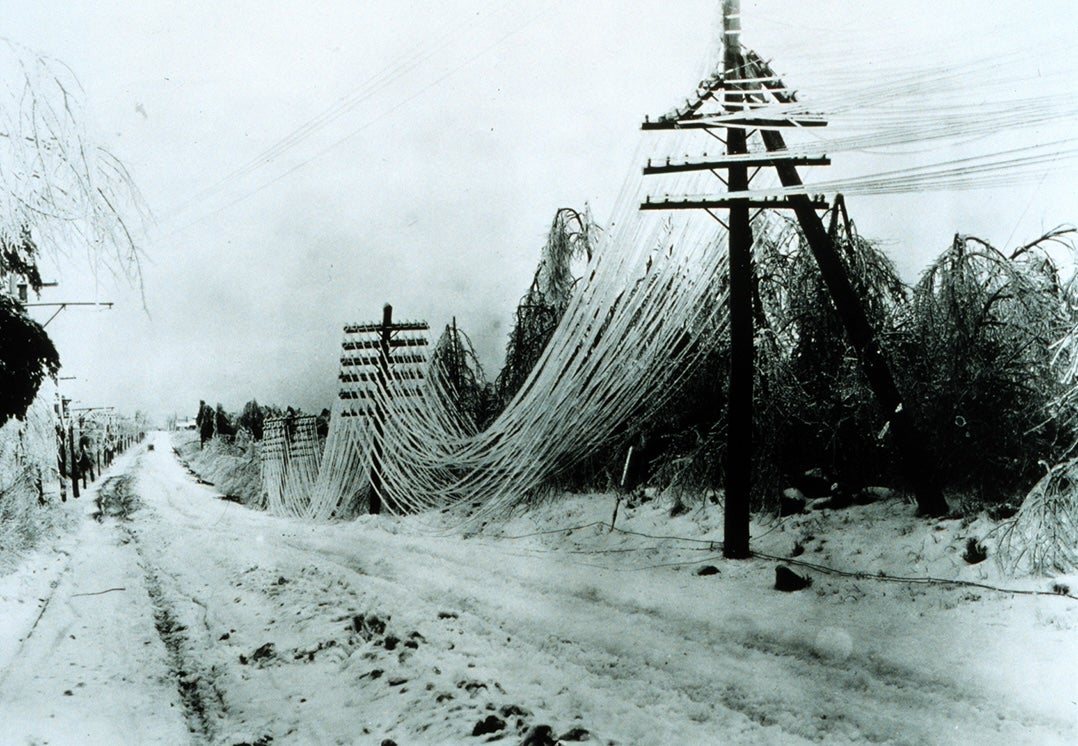Building to weather icing conditions
NSF NCAR scientists help design codes for infrastructure resilience
Mar 31, 2025 - by Audrey Merket
Mar 31, 2025 - by Audrey Merket

Power and telephone lines sagging after a heavy ice storm. (Image: NOAA)
|
Impact statement: Updating structural design standards for icing conditions makes infrastructure more resilient to extreme weather caused by freezing rain. |
Winter weather wreaks havoc on infrastructure in a number of ways, including creating icing conditions that can cause widespread power outages. For example, in 2021, a severe winter storm immobilized infrastructure in Texas, leaving more than 4.5 million homes and businesses without power, some for several days. While there were several factors that led to the worst energy infrastructure crisis in Texas, power lines failing due to icing conditions were a significant contributor.
In order to make communities less vulnerable, structures must be built with these types of extreme weather events in mind. Researchers at the U.S. National Science Foundation National Center for Atmospheric Research (NSF NCAR) are collaborating with SUNY Polytechnic Institute to do just that by updating structural design standards on icing conditions.
Together, they will update the “Icing” chapter in the seventh edition of the American Society for Civil Engineers’ (ASCE) codes and standards for infrastructure resilience (ASCE 7) that is slated to be published in 2028. ASCE guides are an essential resource for engineers, architects, construction professionals, and building officials working on load bearing structures. The current ASCE guide for icing uses a very limited set of historical observations, with large gaps across the country where those observations are insufficient. NSF NCAR researchers will utilize advanced climate modeling tools to better reflect the weather conditions across the country.
“We're not resilient as we stand and any improvement we can make that keeps power on, roads open, and people on the move is beneficial to society and good for the general economy,” said NSF NCAR scientist Mari Tye, who is co-leading the project with ASCE. “This is the first opportunity that I am aware of to directly improve estimates of ice loads used in structural design in the U.S. and will affect infrastructure built now that could last up to 2100.”
This work is funded by a grant from the National Institute of Standards and Technology (NIST).
The "Icing" chapter in ASCE-7 controls the design of critical infrastructure such as electrical pylons, transmission lines, and cable-stayed bridges. Past versions of ASCE guides relied solely on a limited set of historical weather observations that is now outdated and does not account for infrastructure concerns we have today due to increases in extreme weather. In some cases, recommendations may also have been based on drier or warmer years that do not reflect the weather a structure will experience over the course of years to decades.
In the case of icing, there are large information gaps across the country where observations are lacking. In those instances, it is left up to local builders and code enforcers to figure out how to build for potential icing loads in their area. However, those builders and code enforcers aren’t always equipped with the ability to acquire the needed data to calculate expected ice loads or the knowledge of how to analyze the accuracy of their calculations to ensure that infrastructure would be able to endure the reality of extreme weather.
This project seeks to fix that by using advanced climate modeling tools that draw on data from the North American Coordinated Regional Climate Downscaling Experiment (NA-CORDEX), which is hosted at NSF NCAR. The computer models allow researchers to analyze historical freezing rain and use that analysis to project future freezing rain across the entire country. The team is employing ice models and extreme value analysis to quantify the severity and intensity of these events, enabling more accurate predictions and design adjustments.
“One of the key motivations for the creation of the NA-CORDEX dataset is to explore the uncertainty in future projections of complex variables such as future changes in freezing rain,” said NSF NCAR scientist Rachel McCrary, “It is great to be part of the team using this dataset to inform applications and design code, and provide actionable data to end-users.”
The NSF NCAR team will use the model outputs to identify when freezing rain occurs and, after validating that the results are typical, use the information to calculate the typical range of ice thickness. Engineers at SUNY Polytechnic will then take that information and translate the projected ice thickness into a load estimate that will shape ASCE code.
“Sometimes this type of knowledge just gets stuck in the academic community, but by working across disciplines we are able to focus our research in ways that are meaningful to society, and the engineers are able to apply science in ways that shore up our resilience,” said Tye.
For more information, see the SUNY Polytechnic Institute news release.